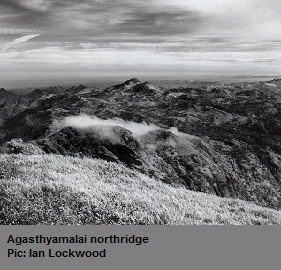Any and all opinions expressed in this newsletter are solely those of the author(s) and do not reflect the opinion of ATREE.
Centre for Excellence in Conservation Science
Royal Enclave,Srirampura,Jakkur Post
Bangalore-560064
Telephone: 080-23635555 (EPABX)
Fax : 080- 23530070
At the heart of the Kalakad Mundanthurai
Tiger Reserve, sharing a border with Kerala's
protected areas, is a distinctive mountain that
is associated with myth as much as it is with
the tremendous biodiversity of its slopes.
Agasthyamalai or Pothigai (as it is known in
Tamil), is no ordinary mountain. Amongst the
steep slopes of scrub forest, valleys of dense
tropical rain forest, and jagged peaks,
Agasthyamalai stands as a sentinel.
Agasthyamalai has a distinct conical profile
that is nearly identical from both eastern and
western sides. From either Trivandrum in the
west or Tirunelveli in the east it stands out as
a distinguished peak amongst a range of
sharp, craggy mountains. Relatively
speaking it is a lesser peak in the chain of
mountains that make up the 1,400 km long
Western Ghats. Dodabetta in the Nilgiris
(2,623 m), Karnataka's Mullayanagiri (1,918
m) and Anai-Mudi (2,694 m), South India's
highest peak are all far higher. Yet, there is
something about Agasthyamalai that
transcends mere height (1,868 m) and size.
Agasthyamalai's profile bears an uncanny
resemblance to Tibet's Mt. Kailash and this
has perhaps lead to its aura and many myths. Agasthyamalai's namesake is derived from
the great sage who is said to have given the
Tamil language to India's Dravidian people
many years ago. Agasthya is associated with
herbal remedies and is often depicted holding
a stone crusher in one hand and a vessel in
the other. The significance of this and the fact
that Agasthyamalai hills are known for their
medicinal plants should not be overlooked.
The most pertinent myth regarding the
mountain relates to Agasthya and the
marriage of Lord Ishwara (Siva) and Parvathi
in the heavenly realm of Mt. Kailash (the
sacred peak in Tibet at 6,740 m). When the
wedding was announced, all the world's
gods, rishis and people migrated north to the
Himalaya. As a result, the earth went
dangerously off balance. With disaster
looming, Ishwara asked Agasthya to go south
and balance the situation through meditation.
After meditating and praying on the mountain
that now bears his namesake the world was
once again put in balance.
As the readers of this journal are well aware
of, the Ashambu Hills play a key ecological
role both from a water and biodiversity point of view. The hilly areas form a critical water
catchment for both eastern and western
coasts. Thus, millions of farmers
dependent on the mountains as a source
water for their crops. While the plains
parched for much of the year the hills
receive as much as 6,000 mm of
d e p e n d i n g o n t h e l o c a t i o n .
Tambraparani is one of the many significant
rivers that have its origins in the forests
Agasthyamalai.
For many years there has been a lowintensity
religious pilgrimage to the summit
Agasthyamalai. A small shrine with a modest
image of Agasthya marks the spot
pilgrims have to take on a 2-3 day arduous
and at times, death-defying trail to get there.
There are approaches from both Kerala
Tamil Nadu with the former being
areas.
popular. The pilgrim's path is generally
well known and forest officials are well aware
of the potential ecological impact that such
pilgrimage could cause if it became popular.
The case of Sabarimalai, just a little to
north, illustrates the danger of open access
spiritual locations in the protected Ten years ago I had a chance to explore and
photograph Agasthyamalai peak on a series
of visits, where I interacted with forest
department officials, pilgrims, Kanis and
conservationists. I can't speak about
changes since that time but certainly in 2001-
02 the area around the peak showed signs of
impact from the pilgrimage. Vegetation had
been trampled and hacked down in places.
Litter, with the ever-present plastic bag, was
noticeable on the approach from Neyyar and
Pepara. This summer, I visited the
Tambraparani near Kariyar reservoir and
noted the steady stream of pilgrims who visit
Banatheertham Falls. Balance is the trick and
forest officials have a delicate task balancing
the needs of growing numbers of pilgrims and
visitors with the strict conservation guidelines
needed to maintain KMTR's remarkable
biodiversity.
Editorial Team
Editor: Allwin Jesudasan
Associate editor: Rajkamal Goswami
Editorial Review: R. Ganesan, M. Soubadra Devy, T. Ganesh
Design and presentation: Kiran Salegame
A S H O K A T R U S T F O R R E S E A R C H I N E C O L O G Y A N D T H E E
N V I R O N M E N T
Geography and myth on Agasthyamalai
-Ian Lockwood
If you have any suggestions or comments please let us know through the boxes below






